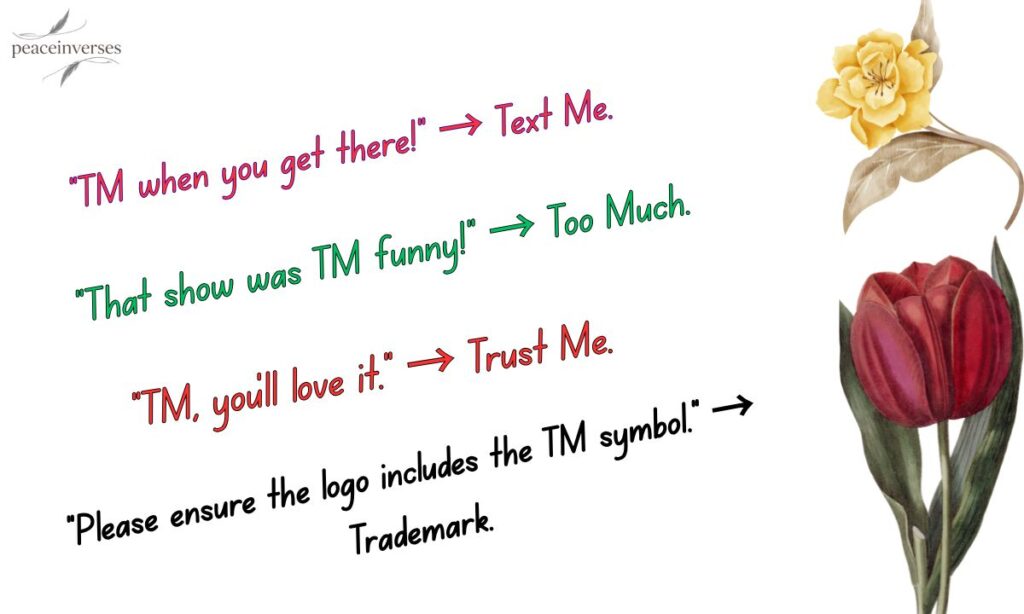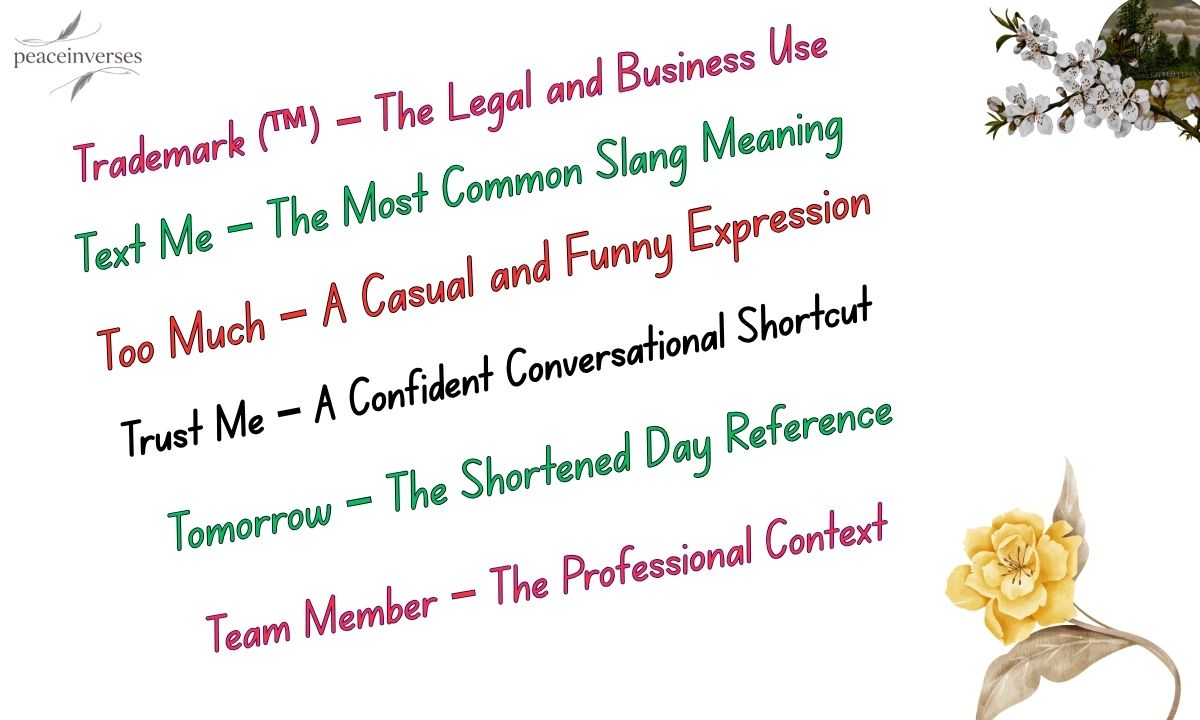Ever come across “TM” in a text and wondered what it really means? You’re not alone. This tiny abbreviation can carry more weight than it seems—from “Text Me” in casual chats to “Trademark” in professional talk. In 2025, it’s one of those shorthand terms that can instantly change tone depending on who’s sending it.
As digital language keeps evolving, understanding TM helps you stay clear, polite, and relevant—whether you’re texting a friend, chatting at work, or posting online. This guide breaks down every common meaning of TM, when to use it, and what to say instead to sound confident and natural in any conversation.
What Does TM Mean in Text Messages?
In texting, TM can mean more than one thing. Its meaning depends on where and how it’s used. Sometimes it’s part of a brand name, other times it’s just a quick message between friends. The context, tone, and platform all decide what the sender truly means. Understanding these differences helps you avoid confusion in chats or professional conversations.
Most people use TM casually, but it’s also seen in work or legal settings. This dual nature makes it one of the most flexible abbreviations in digital communication. To use it right, you should know its most common meanings and how they shift online.
Common Interpretations of TM in Digital Chats
TM doesn’t stick to one definition—it changes based on the person and platform. Below are the most frequent interpretations found in messages and posts:
- Trademark (™) – Used in branding or business contexts.
- Text Me – A friendly or casual way to ask someone to send a message.
- Too Much – Often used to describe something extreme, funny, or dramatic.
- Trust Me – A confident phrase showing assurance or belief.
- Tomorrow – A simple shorthand in fast-paced chats.
- Team Member – A professional term used in workplaces or group projects.
Example:
- “That outfit is TM funny.” → Here, TM means too much.
- “Our company logo carries a TM symbol.” → TM means trademark.
How TM Changes Meaning Across Platforms
Every platform has its own style and tone, which changes how TM is understood. On Instagram or Snapchat, it’s more playful. On LinkedIn or in business emails, it leans toward formal or corporate meanings. Knowing the difference keeps your tone appropriate.
- Instagram or TikTok: Usually stands for “Too Much” or “Trust Me.”
- WhatsApp or iMessage: Commonly used as “Text Me” or “Tomorrow.”
- Email or LinkedIn: Refers to “Trademark” or “Team Member.”
Example:
- “See you TM at the meeting.” → On WhatsApp, it means Tomorrow.
- “Check if the logo has a TM mark.” → On LinkedIn, it means Trademark.
The Most Popular Meanings of TM Explained
Each meaning of TM fits a specific situation. Using the wrong one can make your message confusing. Below are detailed explanations with real examples so you can understand when and how to use each correctly.
Trademark (™) – The Legal and Business Use
In professional or business contexts, TM almost always stands for Trademark. It identifies brand ownership or a legally protected name or logo. You’ll often see it next to a company name or product line.
- Used in: Contracts, product packaging, company bios.
- Avoid in: Casual texting or personal messages.
Example:
- “Make sure the design has the TM next to the logo.”
- “Nike™ shoes are trending this season.”
Text Me – The Most Common Slang Meaning
This is the most common casual use of TM among friends or on social media. It’s quick, simple, and informal. You’ll often see it when someone wants to continue a chat privately or confirm plans.
- Used in: WhatsApp, Snapchat, or Instagram DMs.
- Avoid in: Work emails or formal group messages.
Example:
- “Heading to the party now. TM when you get there!”
- “TM later so we can finalize the plan.”
Too Much – A Casual and Funny Expression
TM also pops up as shorthand for Too Much, often to describe something over-the-top or dramatic. It’s expressive and works perfectly in lighthearted conversations.
- Used in: Memes, captions, friendly texts.
- Avoid in: Professional or serious discussions.
Example:
- “That coffee was TM strong—I couldn’t finish it!”
- “She’s TM dramatic sometimes, but we love her.”
Trust Me – A Confident Conversational Shortcut
In friendly or persuasive chats, TM can mean Trust Me. It’s often used at the end of a message to add confidence or reassurance. The tone depends on how personal or serious the conversation is.
- Used in: Friendly messages, flirty chats, or encouraging notes.
- Avoid in: Business communication where clarity matters.
Example:
- “It’s going to be fun, TM.”
- “TM, this idea will definitely work.”
Tomorrow – The Shortened Day Reference
Sometimes, TM simply replaces Tomorrow. It saves time and suits fast, casual conversations. However, it’s best avoided in messages where clarity is important.
- Used in: Group chats, casual plans, or reminders.
- Avoid in: Work emails or client communication.
Example:
- “Let’s meet TM after lunch.”
- “The meeting’s been moved to TM.”
Team Member – The Professional Context
In office chats or project management tools, TM may stand for Team Member. It helps label roles or responsibilities without typing full titles.
- Used in: Slack, Teams, project dashboards, or HR systems.
- Avoid in: Non-work or social conversations.
Example:
- “Assign this task to the TM handling logistics.”
- “Our TM will update the schedule today.”
Common Mistakes People Make with TM
Many people use TM without thinking about how it might sound. A simple abbreviation can shift meaning depending on where it’s used. The biggest mistake is assuming everyone knows what it stands for. This can lead to confusion, especially in formal or mixed groups.
Another common issue is using TM too casually in professional settings. While it feels quick and trendy, not everyone reads it the same way. The safest choice is to write the full phrase when clarity matters most.
Examples of Misuse and How to Correct Them
Misunderstandings often happen when the tone or setting doesn’t match the meaning. Below are common mistakes and better alternatives for each case.
- “TM the report tomorrow” → unclear; could mean Text Me or Trademark.
- ✅ Correct: “Message me the report tomorrow.”
- ✅ Correct: “Message me the report tomorrow.”
- “This idea is TM cool!” → confusing in business chats.
- ✅ Correct: “This idea is really cool!”
- ✅ Correct: “This idea is really cool!”
- “Add the TM to our slogan” → vague if others don’t know you mean Trademark.
- ✅ Correct: “Add the trademark (™) symbol to our slogan.”
- ✅ Correct: “Add the trademark (™) symbol to our slogan.”
Clear communication keeps your message professional and avoids mixed signals.
Contextual Examples of TM in Real Conversations
Understanding TM in context helps you use it naturally. Each situation—friendly, work-related, social, or romantic—gives TM a new shade of meaning.
Below are examples showing how TM works across different tones and relationships. Use them to recognize when the abbreviation fits and when to replace it with a full phrase.
Friendly Chat Example (Text Me)
In casual chats, TM usually means Text Me. It’s short and easy to use with friends who already understand your texting style.
Example:
- A: “I’m leaving now, TM when you reach home.”
- B: “Sure, I’ll text you once I’m there.”
This version works because both people are comfortable with informal texting.
Work Chat Example (Trademark)
In professional settings, TM often refers to a Trademark. It’s important to use it correctly to avoid legal or branding confusion.
Example:
- Manager: “Make sure our logo includes the TM symbol.”
- Designer: “Got it, I’ll add the ™ next to the brand name.”
Here, TM has a precise business meaning—clear, formal, and appropriate for the workplace.
Social Media Example (Too Much)
On social platforms, TM becomes playful slang for Too Much. It’s used to exaggerate emotions or reactions in a funny or dramatic way.
Example:
- Comment: “That outfit is TM cute!”
- Reply: “Haha, I know right?”
It’s expressive, casual, and fits well in captions or comments where tone is lighthearted.
Romantic Text Example (Trust Me)
In flirty or emotional conversations, TM can mean Trust Me. It adds confidence or reassurance but only works if the other person understands your tone.
Example:
- A: “Are you sure about this plan?”
- B: “TM, it’s going to be perfect.”
In this case, TM sounds confident and warm—but spelling it out as “Trust me” can feel more personal and sincere.
Understanding the Tone Behind TM
Tone decides how your message is received, and TM can sound different depending on who you’re texting. In casual conversations, it feels friendly or playful. But in work settings, it can appear unclear or even unprofessional. Knowing when to adjust your tone helps you send the right message every time.
When texting friends or family, TM adds ease and informality. But when communicating with colleagues or clients, spelling out full words shows effort and respect. Matching tone to context keeps your message natural and appropriate.

When TM Sounds Casual or Friendly
In relaxed chats, TM usually stands for Text Me, Too Much, or Trust Me. It fits well in quick, personal conversations where clarity isn’t a big concern. It adds personality and helps messages feel effortless and real.
You’ll often see it used in short, expressive messages or captions. It’s part of digital slang that keeps texting fun and relatable.
Examples:
- “TM when you get there!” → Text Me.
- “That show was TM funny!” → Too Much.
- “TM, you’ll love it.” → Trust Me.
When TM Should Stay Professional
In professional or business settings, TM should be used carefully. Most people expect full words in emails, reports, or work chats. If you use TM casually, it may seem careless or confusing to others.
The best time to use TM at work is when referring to Trademark or Team Member. These meanings are clear and fit formal communication. Anything else should be avoided.
Examples:
- “Please ensure the logo includes the TM symbol.” → Trademark.
- “The TM responsible for this task will provide updates.” → Team Member.
When to Avoid Using TM in Text
There are times when using TM can cause confusion. In mixed or formal groups, people might interpret it differently, which can change the meaning of your message. When clarity matters, write the full phrase instead.
In professional or international conversations, abbreviations like TM can create misunderstandings. It’s safer to use clear, direct language that leaves no room for guessing.
Avoid TM in these cases:
- Talking to clients or senior staff.
- Sending work-related emails.
- Writing public posts or documents.
- Messaging people from different cultures or age groups.
Advanced Alternatives to TM for Clearer Messages
Using complete phrases instead of TM makes your messages clearer and more natural. Each version of TM has polite, modern alternatives you can use depending on tone and audience.
The following sections show smart replacements for Text Me, Trust Me, and Too Much that work in both casual and professional conversations.
Alternatives When TM Means Text Me
When you want to say Text Me, these options sound friendly but clearer. They fit both casual and semi-formal chats.
- “Message me when you’re free.”
- “Drop me a text later.”
- “Shoot me a message once you arrive.”
- “Let me know via text.”
- “Ping me when you get there.”
Example:
- Instead of “TM later,” say “Message me when you have time.”
Alternatives When TM Means Trust Me
When expressing confidence or reassurance, full phrases make a stronger impact. These phrases work better in personal and professional contexts alike.
- “Believe me, it’ll be great.”
- “You can count on me.”
- “I promise this will work.”
- “Rest assured, I’ve got it handled.”
- “I know this plan will succeed.”
Example:
- Instead of “TM, it’s worth it,” try “Believe me, it’s worth it.”
Alternatives When TM Means Too Much
When something feels overwhelming, using full phrases sounds more natural and expressive. These options fit friendly chats, captions, or polite messages.
- “That’s a bit overwhelming.”
- “This is getting out of hand.”
- “That’s way over the top.”
- “It’s a lot to handle.”
- “This is more than I expected.”
Example:
- Instead of “That movie was TM,” say “That movie was way over the top.”
Why Choosing the Right Alternative Matters
Using the right wording improves clarity, tone, and overall communication. When you avoid shortcuts like TM, your messages sound thoughtful and professional, especially in diverse conversations.
Choosing complete phrases helps people understand your intent without guessing. It shows effort, builds trust, and ensures your tone matches your relationship with the reader—whether it’s friendly or formal.
ChatGPT said:
Cultural Differences in Understanding TM
Language online doesn’t stay the same everywhere. The meaning of TM changes depending on culture, age, and even social habits. Some regions see it as a fun, casual phrase, while others use it strictly for professional or trademark contexts. Understanding these differences avoids confusion and helps your messages sound natural.
In Western countries, TM often means Text Me or Too Much in friendly chats. In contrast, professionals in business-heavy regions may read it as Trademark first. Generational gaps also matter—Gen Z uses it playfully, while older users might take it literally.
How TM Varies Across Regions and Generations
Across social platforms, meanings evolve quickly. Younger users on TikTok or Snapchat use TM in captions like “That’s TM funny,” while older audiences might find that unclear. It’s a sign of how tone and audience shape interpretation.
For example, what feels funny or trendy to one group may seem confusing to another. Before using TM, think about who’s reading your message. That one-second pause helps you stay respectful and clear across all audiences.
Examples:
- “That outfit is TM cute!” → Gen Z slang for too much or adorable.
- “The product name has a TM symbol.” → Business or legal meaning.
Best Practices for Using TM or Its Alternatives
Good communication depends on clarity. Using TM can be fine, but only when your audience understands it. Choosing full words or polite alternatives helps you sound considerate while keeping your message easy to read.
When in doubt, clarity beats trendiness. Writing full phrases like Text Me or Trust Me makes your tone sound confident and prevents misunderstandings, especially in mixed or professional spaces.
Tips for Clear, Polite, and Platform-Appropriate Messaging
Follow these quick tips to use TM or its alternatives effectively:
- Use TM casually only with close friends or peers.
- Replace it with full words in professional emails or group chats.
- Always check your audience’s familiarity with slang before using it.
- Avoid abbreviations in cross-cultural communication.
- Read your message aloud—if it sounds unclear, write it out fully.
Example: Instead of “TM later about that project,” say “Message me later about that project.” It’s clearer and fits all settings.
How Context and Tone Define the True Meaning of TM
Every message carries emotion. TM can sound friendly, confident, or confusing depending on the tone behind it. That’s why understanding context matters more than memorizing meanings.
Using full, clear phrases builds stronger connections and prevents miscommunication. In short, say what you mean—because sometimes, spelling it out is the smartest move in any text.
Final Thoughts
The meaning of TM depends on more than just the letters—it’s about tone, audience, and timing. Knowing how and when to use it can make your communication sound smarter and more thoughtful.
As texting language keeps evolving in 2025, short forms like TM will continue to shift in meaning. The key is balance—being expressive while staying clear. Whether it means Text Me, Trust Me, or Trademark, always let your context guide your choice.

